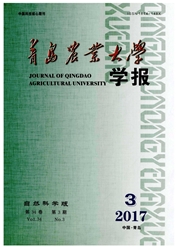

 中文摘要:
中文摘要:
在盆栽条件下研究了培养基质和丛枝菌根(AM)真菌对“京欣一号”西瓜(Citrullus vulgaris Schrad.)生长和产量的影响。将AM真菌Glomus intraradices、Glomus mosseae、Glomus verslforme、Gigaspora rosea和Sclerocystis sinosa接种物各12000接种势单位分别加入盛有草炭土、河砂、蛭石、珍珠岩、砂壤土、石英砂的花盆(3L)内、Glomus mosseae 5000接种势单位加入盛有混合基质(草炭土:砂:蛭石=1:1:1;2:3:1;3:2:1;1:3:2;3:1:2;1:2:3;2:1:3)的营养钵内,然后播种西瓜种子。结果表明,栽培基质和AM真菌对“京欣一号”西瓜植株菌根侵染率、生长发育、产量和可溶性糖含量具有显著影响。其中,以草炭基质、G.mossea和G.versiforme促进西瓜生长、提高产量的效应最大;混合基质中以草炭土:砂:蛭石=3:1:2混配组合最佳。认为当前和今后西瓜无土栽培生产中值得推广草炭基质,同时接种高效AM真菌。
 英文摘要:
英文摘要:
Experiments were conducted to investigate the influence of cultural media and arbuscular myeorrhizal (AM) fungi on the growth and yield of watermelon (Citrullus vulgaris Schrad. , cultivar Jingxin 1). Seeds of watermelon were sown in peat, sand, vermiculite, perlite, sandy loam or quartz sand inoculated with or without AM fungal inoculation. AM fungi,Glornus mosseae Nicolson & Gerdemann, Glomus intraradices Schenck & Smith, Glornus versiforme Bereh, Glornus etunicatum Becker & Gerdemann and mixed inocula of G. rnosseae and Sclerocystis sinuosa (Ger. Bakshi) Almeida & Schenck were used. Seeds were also sown in mixed media with peat, vermiculite and sand in various proportion by volume peat : sand : vermiculite (1 : 1 : 1)(A); peat : sand : vermiculite (2 : 3 : 1)(B); peat : sand : vermiculite (3 : 2 : 1)(C); peat : sand : vermiculite (1 : 3 : 2)(D); peat:sand:vermiculite (3 : 1 : 2)(E); peat : sand : vermiculite (1 : 2 : 3)(F); peat : sand : vermiculite (2 : 1 : 3)(G) inoculated with or without G. mosseae. Significant differences were observed in some treatments with respect to mycorrhizal colonization rates, mineral contents, growth, yield and soluble sugar contents of watermelon. Peat, G. mossea and G. versiforme treatments resulted in the most.beneficial effects on growth and yield of watermelon. Media E proved to be the best combination. So peat, and media E should be used for vegetables grown in soilless media and employed more widely in future.
 同期刊论文项目
同期刊论文项目
 同项目期刊论文
同项目期刊论文
 期刊信息
期刊信息
